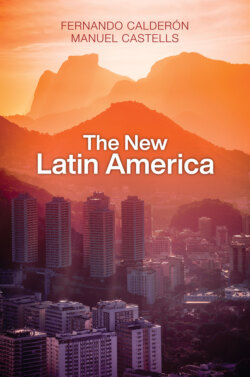The New Latin America

Реклама. ООО «ЛитРес», ИНН: 7719571260.
Оглавление
Manuel Castells. The New Latin America
Contents
List of Illustrations
List of Tables
Guide
Pages
The New Latin America
ACKNOWLEDGMENTS
PREFACE TO THE ENGLISH EDITION
INTRODUCTION: THE NEW LATIN AMERICA
1 THE GLOBALIZATION OF LATIN AMERICA From the Crisis of Neoliberalism to the Crisis of Neo-developmentalism
Socioeconomic Changes
The Rise and Fall of Neoliberalism
Social Resistance and Political Change as Sources of Neo-Developmentalism
Charismatic Leaders, State, and Society
The Neo-Developmentalist Model and the New Globalization: China and the Global South
The Crisis of Neo-Developmentalism
Notes
2 A NEW SYSTEM OF PRODUCTION Informational Extractivism and the Globalization of Markets
Informational Extractivism
Territories
Three Cases: Lithium in Jujuy, Soy in Carlos Casares in the Humid Pampa in Buenos Aires Province, and Unconventional Hydrocarbons in the Vaca Muerta
The Environmental Limits of Informational Extractivism
Notes
3 THE GLOBAL CRIMINAL ECONOMY
The Structure of the Criminal Economy
Transformations in the Criminal Economy
Drugs, Culture, and Society
Why Have Drugs Played Such a Prominent Role in Latin America?
Coca, Identity, and Social Movements
The Criminal Economy and Latin American Societies
Notes
4 HUMAN DEVELOPMENT, URBANIZATION, AND INHUMAN DEVELOPMENT. Human Development in Latin America
Metropolitanization and Inhuman Development
Notes
5 A NETWORK SOCIETY Individualization, Techno-Sociability, and the Culture of Diaspora
The Emergence of Hegemonic Individualism and Consumption: The Centrality of New Media as Vectors of Cultural Construction
The “Culture of Techno-Sociability”: A Culture Centered on Individual Autonomy and as the Nucleus of an Emergent Youth Culture
New Life Experiences
Open Identities
Ethicopolitical Demands that Seek to Confront Insecurity and Strengthen Autonomy
A Dual Logic of Participation
A New Grammar for Social Conflicts
Migrations and the Culture of Diaspora
General Tendencies
The Labor Market, Feminization, and Informality
Migration and Information and Communications Technologies
The Culture of Diaspora
Notes
6 PATRIARCHY IN QUESTION. Changes in the Family and the Crisis of Patriarchy
a. Smaller Households
b. Socio-spatial Differences
c. Incomes
d. Increases in Single-Person Households
e. Female Heads of Household
f. Complex Families
g. Individualization and Differentiation
h. Violence against Women
7 THE CRISIS OF THE CATHOLIC CHURCH AND THE NEW RELIGIOSITY
Notes
8 THE POWER OF IDENTITY Multiculturalism and Social Movements
The Force of Cultural Diversity: Indigenous and Afro-Brazilian Movements
Zapatismo2.0
The Intercultural Peasants of Chapare
The Mapuche Movement
The Afro-Brazilian Movement
People of African Descent
The Emergence and Dynamics of Afro-Brazilian Movements8
Conclusions
Notes
9 DIGITAL COMMUNICATION AND THE NEW PUBLIC SPACE. Introduction
What Is a Public Sphere?: Transformations in the Information Age
New Forms of Communication: The Dynamics of Consumption, the Frustration of Expectations, the Generation of Techno-Sociability, and the Power of Media
The Politics of Media
Social Networks and the Construction of Political Power
Charisma, Communication, and the Web
Some Tendencies in the Reconfiguration of Public Space
The State and the Shaping of a New Public Space
A Novel Challenge: Public Space and Democracy
Notes
10 CONFLICTS AND SOCIAL MOVEMENTS
The Dynamics of Social Conflicts
Conflicts over Social Reproduction
Institutional Conflicts
Cultural Conflicts
Youth Protest2
Women’s Demands and Agency
Environmental Protests
Some Examples in the Andes
Notes
11 STATE CORRUPTION
Determinants of State Corruption
A Typology of Political Corruption
Neoliberalism, Neo-developmentalism, and the Politics of Corruption
Corruption as a Structural Factor
Narcosand the State
The Revolutionary State and Corruption
Can a StateNotBe Corrupt?
Conclusion: The Consequences of State Corruption
12 IN THE KAMANCHAKA
IN PLACE OF A CONCLUSION: THE COLOR OF HOPE
ABOUT THE AUTHORS
REFERENCES. Introduction
Chapter 1
Chapter 2
Chapter 3
Chapter 4
Chapter 5
Chapter 6
Chapter 7
Chapter 8
Chapter 9
Chapter 10
Chapter 11
Chapter 12
FIGURE SOURCES
INDEX
A
B
C
D
E
F
G
H
I
J
K
L
M
N
O
P
Q
R
S
T
U
V
W
X
Y
Z
POLITY END USER LICENSE AGREEMENT
Отрывок из книги
Fernando Calderón and Manuel Castells
Translated by Ramsey McGlazer
.....
Thus, Latin America laid the political foundations for a strategy of development organized by the state, based on the extraction of natural resources for export and the creation of productive infrastructures that would generate funds for the sort of public social spending that could improve living conditions for the population. Statism, productivism, and social welfare were expanded in a process of combined interaction that lent support to neo-populist movements and parties on the left and gave rise to a twenty-first century version of left politics. The success of this strategy, however, depended in large part on charismatic leaders and on the favorable new conditions of the world economy. In this way, a system of corporate patronage and domination was established that would later undergo a general crisis.
The idea of a return to the people, defined as the subject of history and identified with the nation and the state, was fundamental for the construction of the neo-developmentalist strategies that arose in new global and regional contexts. The state and the charismatic leader combine in the popular imagination, becoming fundamental referents for policies that seek both social integration and development, as well as for confrontations with traditional powers and national conservative elites. At the same time, there was widespread and realistic political resistance to negotiations and agreements with transnational corporations and neoliberal states, especially developed countries and China.
.....